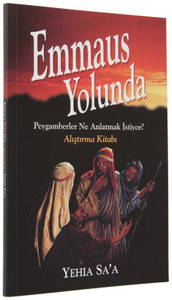This is the Turkish edition of "All that the Prophets have Spoken."
The following description is from the English edition:
As the influence of Islam becomes more widespread, you meet more Muslims. But how do you communicate with them the central message of the Scriptures? Where do you begin? How do you even start?
In their holy book, the Quran, Muslims are told to believe the Torah of Moses, the psalms of David and the gospel of Jesus. And if you've ever spoken with them about the Scriptures, they may have told you that they "believe all the prophets."
While many Old Testament stories are mentioned in the Quran, and both speak of the same prophets, yet there are significant differences in interpretation and understanding. But how do you bridge those differences to present the message of the Bible in a way that they will understand?
“All that the Prophets have Spoken” takes a look at the Word of God from the perspective of a Muslim reader, all without referral to Islam or the Quran. With an awareness of what Muslims believe about key prophets, this book examines what the Scripture has to say about these men and connects them with the core message of the Bible. Keeping in mind the Islamic perspective, the book builds on this understanding and addresses questions Muslims might have, so that by the end, they will have a clear understanding of the God of the Bible.
Örnek bölümler için tıklayın (Read sample chapters)
Features
- Written for adults and teens: Understood by children as young as ten years of age, but written for teens and adults.
- Assumptions: Assumes that when readers think of God, they think of only one God, and that God is a person, not a force. No other Bible knowledge is assumed.
- Muslim worldview: Explains the Bible’s message in way that people from a Islamic cultural background (but not necessarily Muslim by conviction) can understand without mixing the Islamic and biblical worldview.
- Chronological: Begins with the creation of the universe, and then progressing sequentially through key Old Testament stories, it moves into the New Testament to reveal the meaning of the cross and the tomb. The main story of the Bible is tied together into one universal, all-encompassing drama. It follows the same storyline as “The Stranger on the Road to Emmaus” but is 25 per cent different. The difference is significant.
- Based on the gospel of John: Uses the gospel of John as a template; at the same time, provides necessary background stories to give the gospel context. It assumes the reader knows very little, if anything, about the Word of God.
- Objective: The Scripture is allowed to speak for itself in presenting the good news of the Lord Jesus Christ. There is no arm-twisting to believe. The message is presented objectively; the decision to believe or not to believe is left to the reader.
- Peels religious tradition off the Scripture: Readers are introduced to the Word of God without the trappings of religion.
- Bible verses: Told as a story, 1244 Bible verses are woven throughout the text. The reader engages with the text of the Bible for himself.
- Illustrated: Over 100 drawings, maps and diagrams help explain the story.
- Designed to give away: The book can be passed on like a gospel tract. Readers can then learn the Bible's message on their own.
